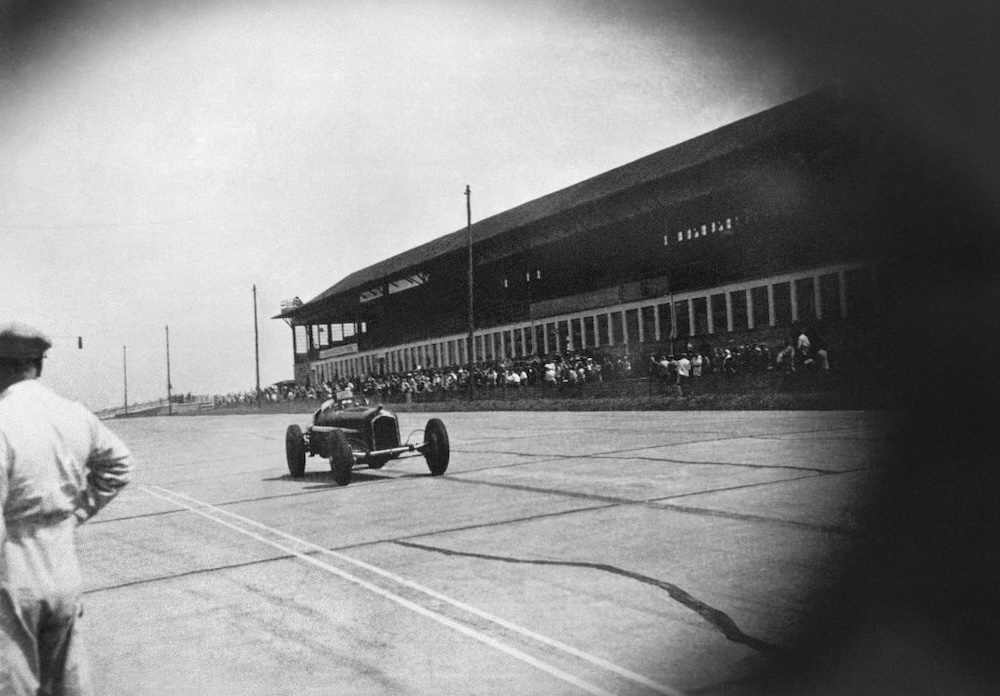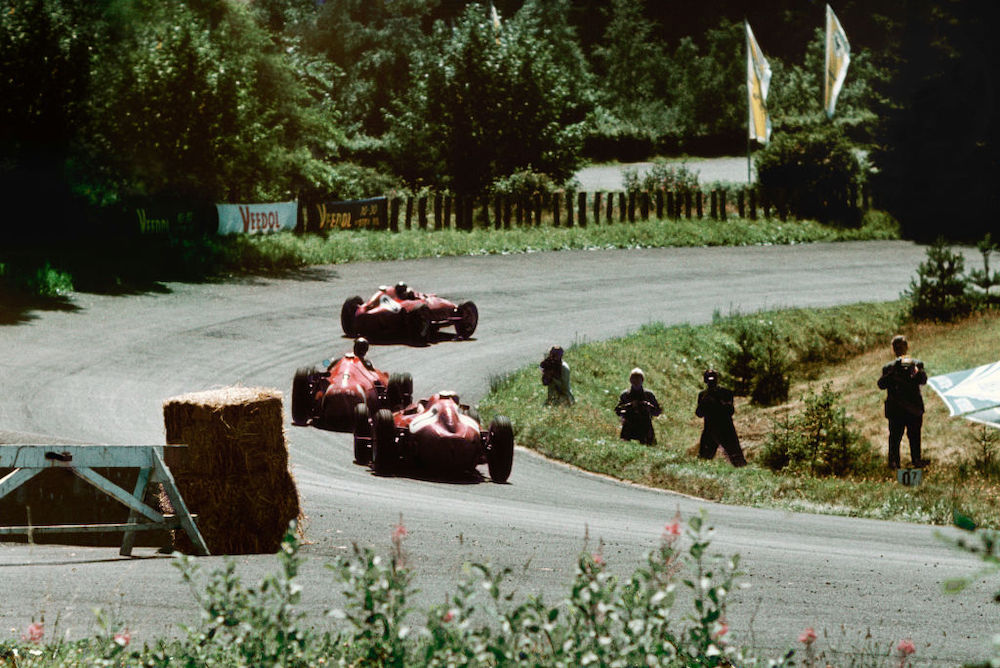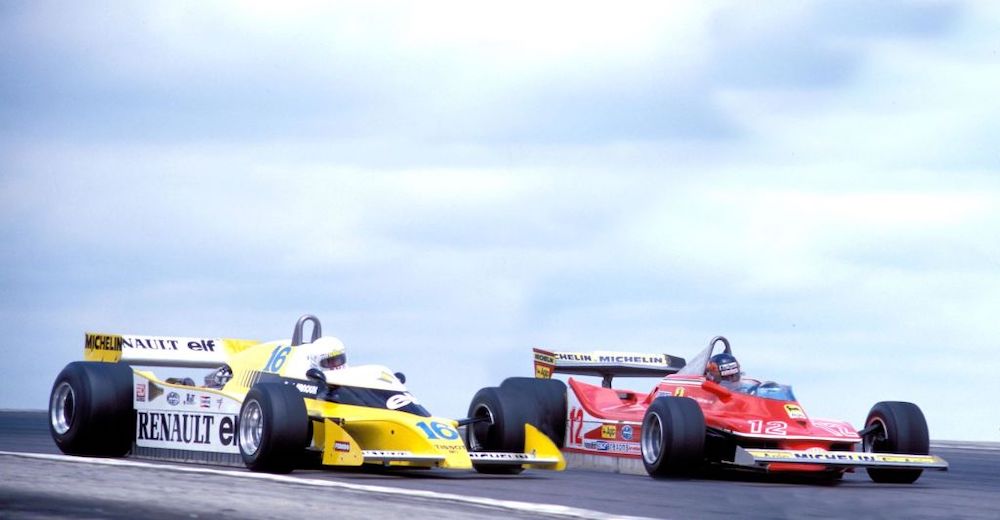The name Francois Hesnault is not one with which you’re likely to be overly familiar. A fine driver in junior formulas in the early 1980s – third and second in two consecutive seasons of French Formula 3 – he appeared to find the step up to uncouth turbocharged Formula 1 cars quite overwhelming.
In ’84 he qualified close to Ligier-Renault teammate Andrea de Cesaris only in the closing races, and his move to Brabham for ’85 was disastrous; alongside already two-time world champion Nelson Piquet, Hesnault was a complete non-entity, and after failing to qualify at Monaco, he was let go. But he did make a one-off return to Formula 1 later that year for the Renault team in the German Grand Prix, joining full-time incumbents Patrick Tambay and Derek Warwick. It would be the final time an F1 team ran three cars at a World Championship GP.
But there’s another reason that Hesnault has a place in F1 history: on that gloomy day at Neue Nürburgring, his Renault RE60 became the first car to start a Grand Prix carrying an onboard camera. Sadly, fate granted Hesnault only eight laps before falling victim to Renault’s lamentable reliability issues that season, but some of the footage gathered is on YouTube.
Compared with the 360-degree views acquired today on numerous Formula 1 and IndyCars through automatically-cleaned lenses, or the helmet-mounted cameras carried by some, the view of Hesnault’s efforts through a dirt-smattered camera probably looks primitive. But at the time it seemed deeply impressive: it didn’t matter that the image was blurred, nor that it was carried by a driver who wasn’t going to be dueling for the lead. Its mere existence gave we TV viewers a better understanding of what our heroes in multi-colored onesies went through from race to race.
For those of us old enough to remember that day 40 years ago (Aug. 4, 1985, to be precise), it still feels like a privilege rather than an expected part of coverage to see the driver’s perspective of exceptional pole-winning laps such as Max Verstappen produced at Suzuka this season, or Lewis Hamilton at Singapore in 2018. I’m sure there have been notable qualifying efforts in F1 in between, but those two stand out because they were on tracks where the consequences of an error are more than a loss of time and a twitch into a parking lot. Perils are necessary. But that’s a rant for another day…
Of course, we had seen driver’s eye perspective F1 action before that. It’s easy enough to find Juan Manuel Fangio testing his Maserati 250F at the Modena Autodrome, Mario Andretti lapping the Indianapolis Motor Speedway in 1966 and a series of clips from “Lap of the Gods” onboards. Patrick Depailler’s performances at Long Beach and at a wet Montreal are particularly fun. But these were all test laps, runs made just before official practice, or occasionally, during practice itself. Mike Hawthorn’s lap of Le Mans in the Jaguar D-type in 1956 is performed at low speed with the roads still open to the public, yet it is still invaluable. Derek Bell’s lap of Le Mans in a works Porsche 956 in 1983 is pure gold, but again, it’s recorded during practice.
So what did we miss? In date order, here’s a list of some of the great performances in motorsport history that we’d love to have seen from the driver’s seat.
The sheer novelty factor means it would be worth paying to see onboard footage of Tazio Nuvolari’s drive in the Alfa Romeo P3 at the Nurburgring in 1935 to see if it’s possible to figure out how the hell he kept the elegant but outpowered Alfa in contact with the thundering Silver Arrows of Auto-Union and Mercedes-Benz, and how he reacted when he passed the hobbled Benz of Manfred von Brauchitsch on that final lap to take an unlikely victory. And speaking of the Silver Arrows, no one mastered the rear-engined Auto-Unions like Bernd Rosemeyer, so witnessing his brilliant final win, at Donington Park in 1937, would be a poignant pick.
I’m not sure I could bring myself to agonize “alongside” Ted Horn over his misfortunes in the Indianapolis 500. Between 1936 and ’48 (IMS was closed from 1942 to ’45 due to World War II), he scored nine consecutive finishes of fourth or better, an extraordinary achievement at a time when racecars were far less reliable than today. Yet he never managed the ‘500’ win that his talents – he was three-time AAA series champion – so obviously deserved. But maybe his brave 1941 drive in the Adams-Sparks car, from 30th on the grid to finish third while nursing an injured arm, would provide gratification that for once at Indy, Horn’s fortunes had at least exceeded his pre-race expectations.

Nuvolari seals the greatest win of his career at the 1935 German GP. You could have put a camera anywhere on that Alfa with zero concerns about upsetting the aero. Getty Images
It’s stretching retrospective imagination to the limit to conceive an open-top sportscar from the 1950s could hold a camera and produce a clear view of the driver and track in wet conditions, but whenever I see reference to the book or movie, the “The Art of Racing in the Rain”, I first think of F1’s regularly acknowledged rain masters such as Rudolf Caracciola, Jacky Ickx, Pedro Rodriguez and Ayrton Senna, etc. but also of José Froilán González in 1954’s 24 Hours of Le Mans. In truth, he probably doesn’t belong with the aforementioned drivers, but in an exceptional season for the beefy Argentine (he finished runner-up in the ’54 F1 World Championship), his standout performance came in sportscar’s round-the-clock classic, driving a Ferrari 375 Plus. Partnered with Maurice Trintignant, González captured the second win for the Ferrari marque but the first for Scuderia Ferrari. Pressed hard throughout by Jaguar D-types and losing time on pitlane due to his engine’s reluctance to restart due to heat-soak and dampness, Gonzalez had to dig deep for this glory. To harness the 340hp output of a five-liter V12 in a car with a shorter wheelbase than the current VW Golf, on bias-ply tires on a soaking track, took the skills of a master. To do it for 18-19 hours, faster than any of the opposition, took skills that maybe even Gonzalez didn’t previously know he possessed. An onboard would have been exhilarating.
AI informs us that to film 10 hours, seven minutes and 48 seconds of content on 16mm film, one would have required 61 rolls of film, so recording an onboard of Stirling Moss and Denis Jenkinson in their Mercedes 300SLR on the Mille Miglia in 1955 would have been quite unfeasible… Oh, and changing reels every 10 minutes would have added to Jenks’s duties to the detriment of his navigation. But hey, we’re talking fantasy here, and there could be no better way to spend such a huge chunk of time than learning how to average 97.96mph on public roads on the 992.332-mile roundtrip from Brescia-to-Rome-to-Brescia. It’s one of the greatest feats in the history of our sport.
Those seeking a much shorter adrenaline shot might prefer Eugenio Castellotti’s qualifying lap for the 1955 Belgian Grand Prix – and would enjoy the added frisson of knowing just what it meant to the driver. At a time when Mercedes was painting F1 silver with its dominant W196, and barely nine days after losing his mentor and Scuderia Lancia teammate, Alberto Ascari, 24-year-old Castellotti lapped the fearsome 8.8-mile Spa-Francorchamps course half a second faster than Fangio’s Mercedes to claim pole position. The following year, Fangio would join him at Ferrari and together they would win the 12 Hours of Sebring; a few months later, Castellotti would conquer the Mille Miglia. But in his all-too-short life, arguably his greatest achievement remained that 4m18.1s blast around Spa in the Lancia D50.
Speaking of Fangio, our next “wish-we-there-in-the-cockpit” is obvious: it has to be the 1957 German Grand Prix at the Nürburgring. But would you choose to have a rearward-facing camera from the cockpit of Mike Hawthorn’s Ferrari Dino 246 to watch first his teammate, Peter Collins, or the approach of the maestro’s menacing Maserati 250F? Or would you go for an over-the-shoulder view of Fangio’s most astonishing drive in a career full of them? The facts are these: Fangio took pole with a 9m25.6s lap. Seeing the Ferrari stars fill their fuel tanks for the race, he elected to run on half-tanks and make a pitstop. He had a half-minute lead when he pitted on lap 12 of 22, but the stop was a disastrous Maser mess, that included a dropped wheelnut. By the time Fangio was underway, he was 50 seconds behind leader Hawthorn, but he reset the lap record nine times – eventually leaving it at 9m17.4s – to pass the Ferraris on the penultimate lap, score his last win and seal his fifth and final championship. Wouldn’t we all love to know just how the great man produced a drive that he admitted afterward scared him? How much more speed was he carrying into/through/exiting turns? Were the gains small but at all 176-plus turns of the 14-mile ’Ring, or were there particular corners where he was 10mph faster than the Ferraris? On reflection, yes, let’s have that onboard camera fitted to the Maserati…

